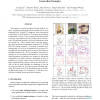69
Voted
ICPR
2008
IEEE
15 years 7 months ago
2008
IEEE
Support Vector Machines (SVMs), though accurate, are still difficult to solve large-scale applications, due to the computational and storage requirement. To relieve this problem,...
117
Voted
IAT
2009
IEEE
15 years 7 months ago
2009
IEEE
—We describe the design of an autonomous agent that can teach itself how to translate from a foreign language, by first assembling its own training set, then using it to improve...
101
click to vote
CVPR
2010
IEEE
15 years 8 months ago
2010
IEEE
This paper proposes a context-constrained hallucination approach for image super-resolution. Through building a training set of high-resolution/low-resolution image segment pairs,...
75
Voted
ISBI
2008
IEEE
16 years 1 months ago
2008
IEEE
Model-based segmentation approaches, such as those employing Active Shape Models (ASMs), have proved to be useful for medical image segmentation and understanding. To build the mo...
91
Voted
ICIP
2002
IEEE
16 years 2 months ago
2002
IEEE
In previous work [2] we considered the problem of image interpolation from an adaptive optimal recovery point of view. We showed how a training set S determines a quadratic signal...
ICIP
2005
IEEE
16 years 2 months ago
2005
IEEE
In this paper, we propose a novel framework for face super-resolution based on a layered predictor network. In the first layer, multiple predictors are trained online with a dynami...
102
Voted
ECCV
2002
Springer
16 years 2 months ago
2002
Springer
We describe an automatic method for building optimal 3D statistical shape models from sets of training shapes. Although shape models show considerable promise as a basis for segmen...
114
click to vote
ICCV
2007
IEEE
16 years 2 months ago
2007
IEEE
In this paper we present an empirical study of object category recognition using generalized samples and a set of sequential tests. We study 33 categories, each consisting of a sm...





